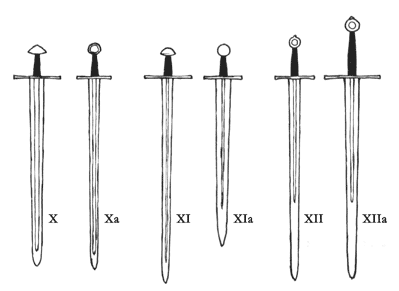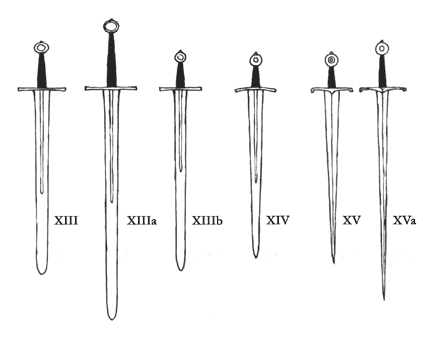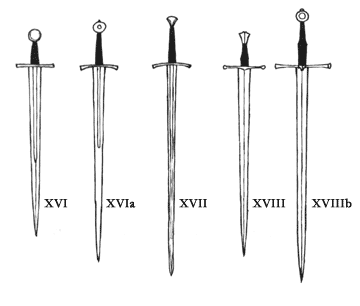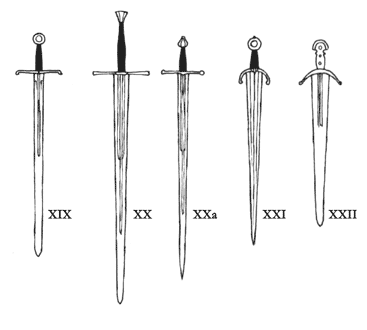
 |
||||||||
|
|
||||||||
Oakeshott's
Typology - An Introduction
By Björn Hellqvist
Drawings by Peter Johnsson
This is an attempt to introduce the reader to Oakeshott's sword blade typology. Ewart Oakeshott is perhaps the most noted student of swords, and his contribution to our knowledge is significant. In order to make his research easier, he divided the swords into types. In contrast to other typologies, like Petersen's Viking sword typology that only focuses on the hilt form, Oakeshott's typology concentrates on the blade and its function. His system makes it easier to date the swords, and coupled with his classifying of the hilt parts it become rather easy to tell the approximate age of a certain sword. The typology isn't complete or perfect, something Oakeshott is the first to admit, but it is nonetheless one of the best ways to understand the development of the medieval sword. Please note that the swords illustrated are single specimens, and that there are variations within each type.

Type X characteristics: The type X blades are broad and of medium length (avg. 31"). The wide fuller runs almost the whole length of the blade before fading out about an inch before the point. The point itself can be acute, but is usually rounded. The type was common during the Viking age, and continued to be popular well into the 12th century.
Sub-type Xa characteristics: This type is similar to the type X, but the fuller is more narrow. The blade is a little longer than the average type X (which is around 31 inches). It was in use from c. 1000 AD to about 1300.
Type XI characteristics: This type differs from type X by being longer, more narrow and having a narrow fuller. The point is often acute. It is believed to have been in use between c. 1100 and 1175. The sub-type XIa has a broader and shorter blade, but the fuller is still narrow.
Type XII characteristics: The blade is broad, flat and evenly tapering. Oakeshott's criteria for this type (in order to differentiate from other, similar, types) are: 1) a noticeable taper and an acute point, and that the grip should be short (never of hand-and-a-half length), and 2) that the fuller should not extend further than 2/3's of the length of the blade. The type XII swords are easily confused with other types, and this is further complicated by the fact that type XII's were in use during much of the High Medieval period.
Sub-type XIIa characteristics: This is basically a "Great Sword" (or "war sword") variety of type XII. The grip can be gripped with both hands. This type could be encountered during the 13th and 14th centuries. They weighed in at about 3 to 4 lbs.

Type XIII characteristics: This type has blades with almost parallel edges running to a rounded point, and where the tang is longer than those of the usual single-handed variety. Generally, the fuller runs about halfway along the blade. The fuller is usually single, but it can be multiple. The type was in use from the middle of the 13th century to the latter half of the 14th. The same goes for the sub-types.
Sub-type XIIIa characteristics: This type is a sub-type of XIII, often called "Great Swords", "War Swords", etc. The swords have very large blades, often 32" - 40", and grips of 6" to 10". Generally, the fuller runs about halfway along the blade.
Sub-type XIIIb characteristics: This is a type XIII with a short grip.
Type XIV characteristics: This distinct type was in use between c.1275 and 1340. It is easy to recognise due to the rather short blade, which starts out broad and tapers (usually) to an acute point. The grip is relatively short. The fuller is usually of 3/4's length. Multiple fullers can be seen in a few specimens.
We've seen that the first five types and five sub-types have been swords more suited for cutting/chopping than thrusting. With the advent of plate armour, the swords had to become stiffer and more suited for thrusting. Instead of having fullers and relatively parallel edges, the swords now became more tapering and of diamond cross section.
Type XV characteristics: This is a very straightforward type. Tapering, straight edges, diamond cross section and pointy - made for thrusting. Oakeshott traces the origins of this type to the end of the 13th century, but it became more widely used in the 14th and 15th centuries, falling out of use in the beginning of the 16th century.
Sub-type XVa characteristics: This type is similar to the XV, but generally with a more narrow and slender blade. The grip is much longer, from 7" to 9" (10" in a few cases).

Type XVI characteristics: This type was developed as a response to the plate-reinforced mail armour of the early 14th century. It can be hard to distinguish this type from type XIV, but the lower part is almost exclusively of pronounced diamond cross-section - more so than on the XIV. This provides a stiff thrusting point while retaining good cutting ability. The blades are usually between 28" to 32", with a distinctive fuller extending a little over half the length of the blade.
Sub-type XVIa characteristics: Type XVIa has a long, rather slowly tapering blade, broad at the hilt and often with a reinforced point. The fuller is often well-marked, extending about 1/3 (rarely more than half) of the blade's length. The lower part is not of diamond but of flat, hexagonal section. The hilt is long, 6" to 9" like the XIIIa and XVa, allowing for a two-handed grip.
Type XVII characteristics: The blade of this type is long, slender and acutely tapering. The cross-section is generally hexagonal. Many examples have a shallow fuller in the upper quarter of the blade. The grip is always long, allowing two-handed use. It was in use between c. 1360 and the 1420's, and was probably designed for punching through armour. The swords of this type were generally very stout, and could weigh as much as 5.5 lbs. (compared to the 3.5 to 4 lbs. of the XIIIa). This makes Oakeshott believe that these swords were used for cracking plate armour.
Type XVIII characteristics: These blades are fairly broad (2"-2½") at the hilt, and taper gracefully to a sharp point. The hilt is short, intended for one-handed use. The blades are of flattened diamond cross-section, often with a pronounced mid-rib for rigidity. This style is very well adapted for both cutting and thrusting.
Sub-type XVIIIa characteristics (not shown): This type is fairly slender, having an average length of 32". The section is the same as the XVIII, but some have a narrow fuller in the upper part. One thing that sets them apart from the XVIII's is the grip, which is about an inch (or so) longer than on XVIII (5"+ as opposed to 4").
Sub-type XVIIIb characteristics: The blade is long, slender and acutely pointed, and, like it's brethren of this type, of flattened diamond cross-section. The hilt is very long, often around 10"-11". This type is encountered between c. 1450 and 1520.
Sub-type XVIIIc characteristics (not shown): Like all swords of this type, the blade is of flattened diamond cross-section. It is broad and generally about 34" long. The grip can be used with one or both hands.

Subtype XIX characteristics: This type has a broad, flat blade, with the edges running almost parallel to a sudden sharp point. There's a narrow fuller in the upper third of the blade, as well as a ricasso. The cross-section is hexagonal - the blade is flat with chamfered edges. This type appears by the beginning of the 15th century and is intended for single-handed use.
Type XX characteristics: This type was in use in the 14th and 15th centuries. The swords are hand-and-a-halfers, similar to type XIIIa, the broad blades having almost parallel edges gracefully tapering to a point. The fullers are usually one central fuller running more than half-way down the blade, with two parallel fullers in the upper quarter of the blade.
Sub-type XXa characteristics: This sub-type of XX has a less broad blade, which narrows rather sharply to an acute point. The fullers like those of type XX.
Type XXI characteristics: This late 15th century type is similar to the well-known Cinqueda short-swords, but the blades are not necessarily that broad ("five fingers wide"), and they are as long as ordinary one-handers. The hilts of some are very much like those of the Cinquedas, but others are like ordinary swords. The blade is slowly tapering to an acute point, and there are usually a couple of rather wide and shallow fullers in the upper part of the blade, or two fullers running almost the entire length of the blade.
Type XXII characteristics: This is a broad, flat blade from the end of the 15th century, the edges tapering gracefully to an acute point. There are two short, deep and narrow fullers close to each other just below the hilt.
Sources:
Ewart Oakeshott: The Sword in the Age of Chivalry (Boydell & Brewer, 1964, 1994)
Ewart Oakeshott: Records of the Medieval Sword (Boydell & Brewer, 1991)
Peter Johnsson: Svante Nilsson Stures svärd (privately published,1999)
|
|
|||
|
|
|||
|
|||